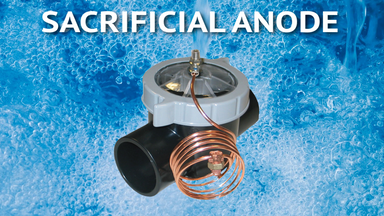Published by Matt Fichera on 01/16/2023
What is a Sacrificial Anode for Your Swimming Pool?
A sacrificial anode is a simple device that is easy to install and economical. It works to preserve and protect metal components of a swimming pool’s operating system from salt water corrosion. It conducts electricity when currents pass through it during electrolysis. Electrolysis is what a salt system uses to produce its own chlorine. These types of anodes are readily available in many different shapes and sizes depending on equipment size and exact placement within the pool system.
How Does a Zinc Anode Work?
Did you know that if you have a salt water chlorination system in your swimming pool that anything which is metal and immersed in the water, is actually producing an electrical charge? This means any metal components are also at risk of corrosion, especially over extended periods of time. The anode “sacrifices” itself from any electrical charge that may flow into your water and works to preserve other components like ladders, steps, filters, fittings, light fixture housings, or components of a pool heater.
A zinc sacrificial anode works to protect metal in your pool through a process called cathodic protection. Zinc, by definition, has a more active voltage than the other metals and will break down before any damage is done to the surrounding metal materials. Oxidation and reduction take place on the sacrificial anode and not the other metal components located in your pool.
An anode should last anywhere from 6 to 12 months and it’s important to keep tabs on its condition and replace if considerably broken down or degraded. Good times to check the anode are during both pool closing and opening or once in the spring and once in the fall, if your pool is open year-round.
Is a Sacrificial Anode Always Needed?
It is difficult to say if a sacrificial anode is absolutely needed with every salt water pool. Different variables come into play such as overall water chemistry and any types of metals that exist in your pool’s system. Perfect pool balancing remains a hard thing to conquer and even when pH is at a perfect 7.4 there remains other factors such as alkalinity and chlorine production that can cause galvanic corrosion. Another factor to consider is the type of metal making up the components in the pool. Modern ladders, steps, and light housings are composed of stainless steel that resists corroding, but older accessories could be made of a lower grade steel or steel plating that is more susceptible to corrosion.
Where Do You Install a Sacrificial Anode?
If you have made the decision to go with a sacrificial anode, the most important part of installing it is to ensure that it is connected to the bonding wire of your pool system. This bonding wire should encompass your entire electrical system of your pool and by connecting the anode to this system, you are protecting it in its entirety. The most ideal spot to place an anode is as an “in-line” device between the filter and the heater. It sits in a “T” PVC junction and is easily plumbed into the system by a handy pool owner or a service technician. Once this is completed, the anode can usually be replaced by simply unscrewing the cap. Replacement should be expected every 6 to 12 months.
Would We Recommend a Sacrificial Anode?
The answer is “Yes”, we would recommend a sacrificial anode as an affordable way to have peace of mind and to prevent potential costly damage to hardware or sensitive pool surfaces. There are different types available on the market, which include devices that sit in your skimmer basket to more complex products that plumb into your swimming pool’s system. If you don't mind spending a bit of money you will be glad you decided on adding this handy device to your salt water pool. At EZ Pool & Spa Supply, we offer different types of anodes available for purchase and would be happy to help answer any questions that you may have.





